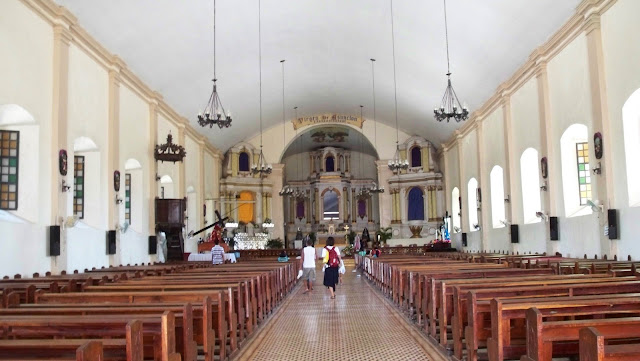Maundy Thursday: (April 9) We left Manila at 2am then arrived in Ilocos almost 5pm... whew! Not a long trip huh!.. hehe
Usually, we only go as far as La Union then Baguio. But this time is quite different coz we had crossed the border by heading Ilocos. And the truth is, we didnt know where are we truly heading since it's our first time and we ain't know no one from there. So we just enjoyed the road trip anyway.
On our way, we did Visita Iglesia (a traditional Filipino custom of visiting seven churches on Holy Thursday to pay respect to the Blessed Sacrament)
First stop: Basilica of Our Lady of Charity @ Agoo, La union.
 the church's wall painting that said to have Imelda's face on each angels
the church's wall painting that said to have Imelda's face on each angels me and klyne on the tree house located just across the church
me and klyne on the tree house located just across the churchSecond: San Juan De Sahagun Parish @ Candon City, Ilocos Sur
Third: Nuestra Senora de la Asuncion church @ Santa Maria, Ilocos Sur
This church was built by the Augustinians with an 82-step stairway in 1765. This church gives visitors a good panoramic scenic view ofthe town and the green fields and the blue sea in the horizon. This church served as a fortress during the Philippine Revolution in 1896. The Nuestra Señora de la Asuncion Church in Sta. Maria town was designated as a National Historical Landmark on Sept. 26, 1982, and was included in the World Heritage List on Dec. 11, 1993.
 Enshrined in the church is the Virgin’s statue made of wood in ornate
Enshrined in the church is the Virgin’s statue made of wood in ornatesculptural style, with ivory face and hands.
More photos at:
Ilocos Sur getaway
Fourth: Vigan Cathedral
St Paul's Metropolitan Cathedral also known as Vigan Cathedral faces Plaza Salcedo, and is an imposing creamy-white building built in the "earthquake baroque" style with thick buttresses to support it through earthquakes and typhoons. A separate belltower (or belfry) was built 15 meters away from the main building -- so that if one structure was destroyed in an earthquake, then the other might still remain standing. The belltower is about 25 meters high and it is surmounted by a large bronze weathercock that is said to symbolize St Peter.
The first church was built on this site in 1574 (by Juan de Salcedo) and was damaged in the earthquakes of 1619 and 1627. A second was built here in 1641; and the present baroque-style church was built in the 1800s.
Fifth: Church of Paoay
St. Augustine Church popularly known as Paoay Church was built in 1694 and was completed in 1710. It was commissioned by the Augustinian friars led by Fr. Antonio Estavillo.
This Church is a unique combination of Gothic, Baroque and Oriental designs. Its facade reveals Gothic affinity, its gables show Chinese elements, while the niches topping the walls suggest Javanese influence (reminiscent of the famous Boroboudur Temple).
Known as the “Earthquake Baroque” church in the Philippines, Paoay church was built of baked bricks, coral rocks, salbot (tree sap) and lumber, and has 24 carved massive buttresses for support. It is an architectural solution to the area's challenging, natural setting. Both sides of the nave are lined with the most voluminous stone buttresses seen around the islands. Large coral stones were used for the lower level while bricks were used for the upper levels of the church. The walls are 1.67 meters thick made of the same materials. Its bell tower, which is detached from its main building, is made of coral stone. It stands a safe distance away to spare the sanctuary in case of collapse.
 Originally, the church roof was thatched; and it is conjectured so that buttresses not only support walls but give roof access during fire and typhoon.
Originally, the church roof was thatched; and it is conjectured so that buttresses not only support walls but give roof access during fire and typhoon.Sixth: Sto. Domingo Parish, Sto. Domingo, Ilocos Sur

Seventh: Sto. Nino de Paz Chapel @ Greenbelt

















No comments:
Post a Comment